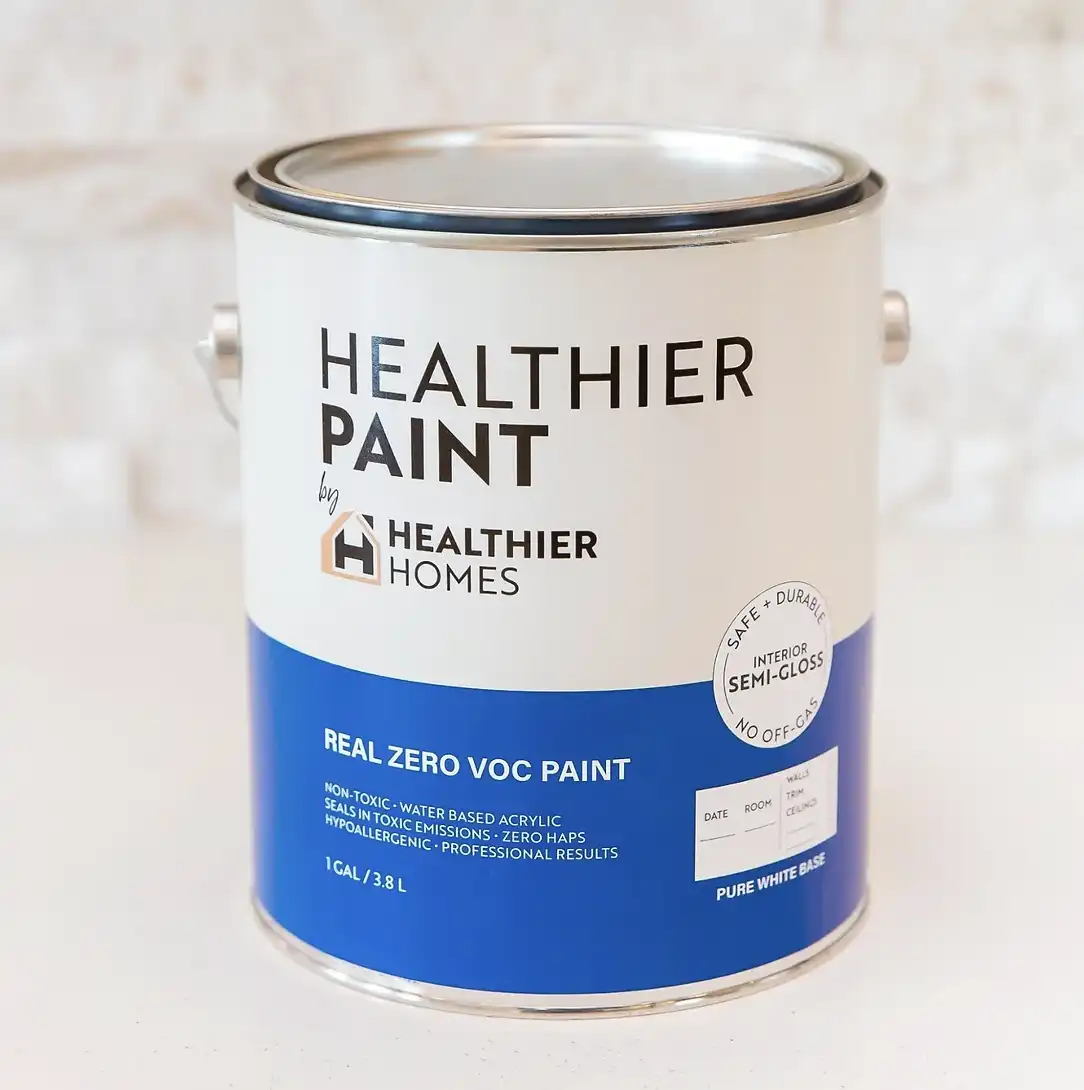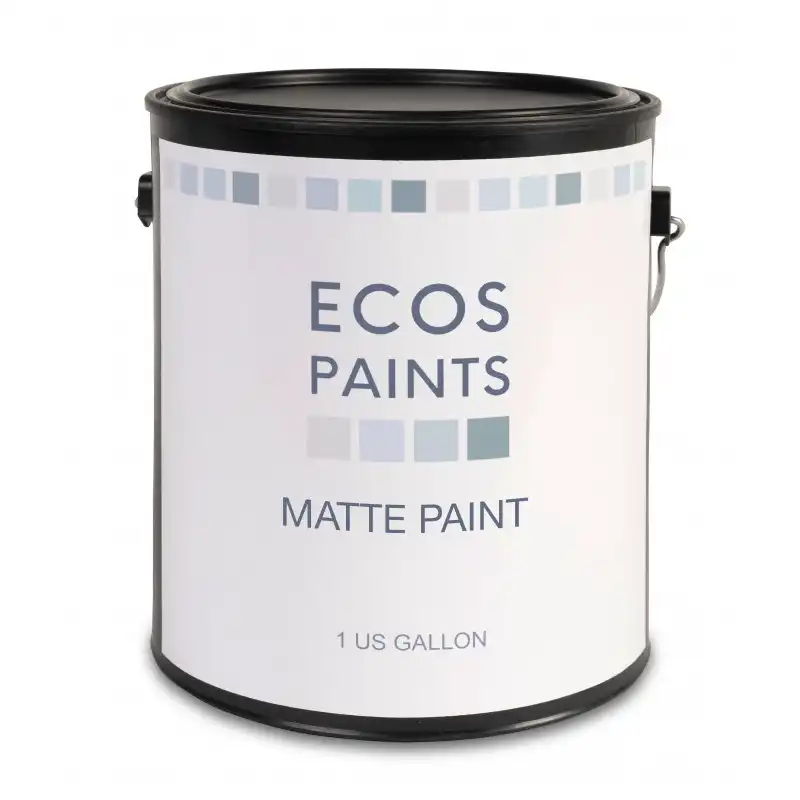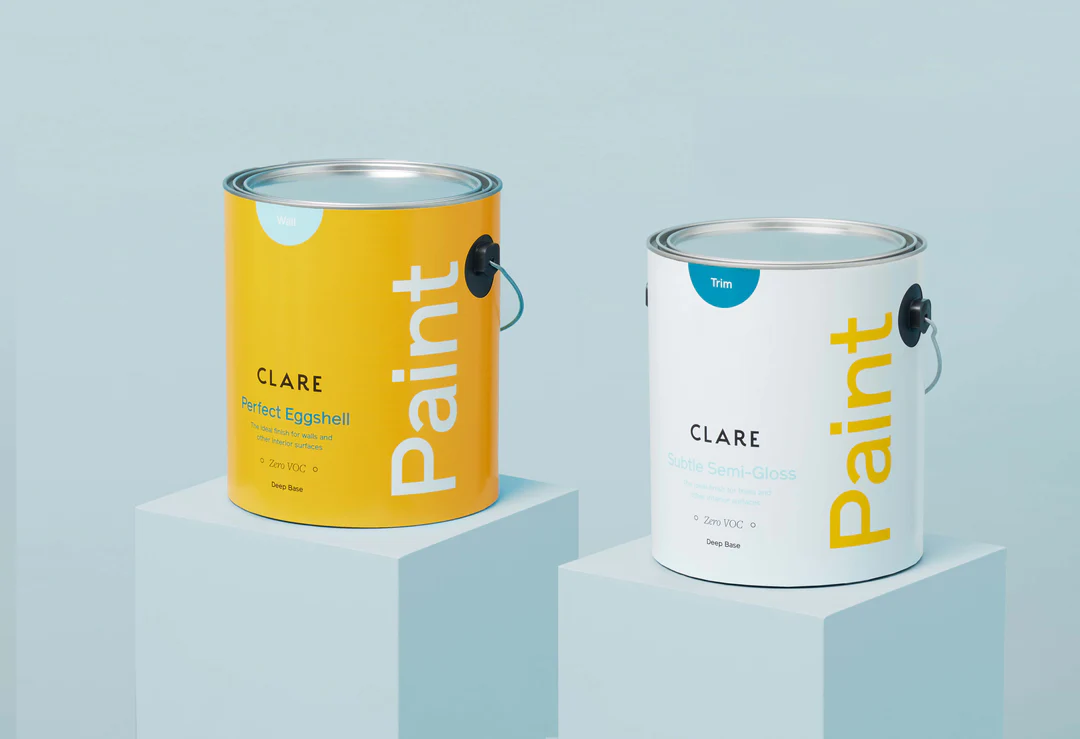Looking for the best non-toxic paint for your nursery? Here are 4 brands that are going above and beyond to ensure healthy, baby-safe air quality from the paint in your home.
When it comes to designing a nursery, every detail matters. From the crib to the curtains, it is not uncommon for parents to put in endless hours of thought to make sure that their little one’s environment is perfect in every way. There is no compromising on warmth and safety.
However, one aspect that often gets overlooked is the type of paint that ends up on the nursery walls. If you want to create a nurturing and safe space for your new baby, you absolutely should consider the materials you’re using in your nursery.
Paint contains harmful chemicals and also offgass causing a myriad of health issues. They also contain things like alkylphenol ethoxylates which are estrogenic (endocrine disruptors) and carcinogenic to humans. This is why it’s a good idea to use the safest paint possible for your nursery!
In this article, I’ll guide you on everything you need to know about non-toxic paint for nurseries so you can choose the best paint for you!
This post may contain affiliate links.

We’ll talk about its benefits, the various types, and how to choose the best option for you. We’ll also walk you through how to apply them on your walls. Hopefully, by the end of this guide, you will be equipped with everything you need to create a nursery that’s not only visually appealing but also genuinely safe for your little one.
Sounds good? Great! Let’s begin!
4 Best Non-Toxic Paint Choices for a Nursery
Here are some of the best non-toxic paints for your baby’s room that you can buy right now:
1. Healthier Homes – Top Pick
At $72 per gallon, Healthier Homes is a brand of water-based acrylic paint that is made from nontoxic acrylics, blended with natural ingredients like organic clay and minerals.
Their natural paints and primers are created to block chemical off-gassing which makes them unique when it comes to zero-VOC paints (volatile organic compounds) and reduces indoor air pollution.
They are odorless – making them incredible for a nursery – and are made without hazardous air pollutants (HAPs) and harmful chemicals like ammonia, acetone, aromatic petroleum solvents, PVC, formaldehyde, biocides, or paraffin wax.
The paint has a smooth, easy to apply texture and they can color match different colors and brands for you to create a warm and cozy atmosphere in your nursery.
Plus, for every gallon of paint purchased, they remove 100 plastic bottles from the ocean. Healthier Homes makes some of the best baby-safe paints on the market. And they offer a wide array of healthier home good to go along with your updated space as well!
2. ECOS Paints:
ECOS Paints water-based paints are made with ingredients including kaolin clay, hydrogen peroxide, sodium salt, and mineral oil. ECOS paint options have a smooth and durable finish.
They are proudly made in the USA and are color match any color you’d like to brighten up your nursery starting at $88.75 per gallon. The also offer paint for baby furniture, like your baby’s crib, for example.
3. Clare Paint :
This brand makes its paints using water-based acrylics and additives. They are available in matte and satin finishes. Their paints:
- and colorants are zero VOC
- are Greenguard Gold Certified
- ultra low odor
- have no hazardous air pollutants
- have no toxic air contaminants
- have EPA (Environmental Protection Agency) chemicals of concern
They don’t offer color-matching but have a raved-about designer-curated color collection to simplify your home decorating process. The paints are also self-priming and stain resistant.
4. AFM Safecoat:
AFM Safecoat is a brand of non-toxic paint that is made from plant-based alkyds and oils. The company makes natural color paints with a range of beautiful finishes. They look great in any nursery. The paints are also very easy to apply and also highly durable.
To purcahse this paint, you’ll have to call a local dealer or locate a store near you.
Top 4 Benefits of Using Non-Toxic Paint In Your Nursery
First things first. Why should you use non-toxic paint for your baby’s nursery?
Well, using non-toxic paint for nurseries has many advantages. These benefits apply to both you and your little one. Here are some of them:
- Improved air quality: Non-toxic paint does not emit VOCs or other harmful substances. Some of these substances such as VOCs not only lower your indoor air quality but also can lead to various health problems such as headaches, nausea, dizziness, eye irritation, respiratory issues, or even cancer. Additionally, non-toxic paint does not have a strong smell that can linger for days after painting. Whenever you use it, you ensure that your nursery room has fresh and clean air that is safe for you and your baby to breathe. Children and babies are more susceptible to health risks from paint.
- Reduced health risks: Non-toxic paint does not pose health risks to you or your baby like traditional paints. In fact, even if you accidentally ingest or inhale it, the risks are less than with traditional paint, though still contact your doctor, emergency department or poison control. It is also less likely to cause allergic reactions or skin irritations than conventional paint. In this way, non-toxic paint protects you and your kiddo from potential health hazards.
- They are great for enhancing mood and creativity: Non-toxic paint comes in a wide range of colors and finishes. You can choose colors that are soothing or stimulating for your nursery. Studies have shown that colors can affect our mood, emotions, and behavior. For example, blue can promote calmness, yellow can boost energy, and green can foster creativity. Combine these effects with non-toxic paint and you get to create a positive and pleasant atmosphere in the nursery, perfect for enhancing you and your little one’s mood and creativity.
- Protects the environment: Non-toxic paint is eco-friendly and sustainable. It does not contribute to air pollution or waste generation. It is also biodegradable and recyclable, which means that it does not harm the environment when disposed of. In this way, when you use non-toxic paint, you reduce your impact on the environment while also supporting the conservation of natural resources.
Many commercial paints contain toxic chemicals. Choosing zero-VOC and non-toxic paint, like from Healthier Homes for example, is the safest option for young children. It’s a good idea to use baby safe paint as compared to traditional paints, and in the very least it’s a small change that can give you peace of mind that your baby is breathing better quality air.
The Types of Non-Toxic Paint
Now that we’ve explored the compelling reasons to choose non-toxic paint for your nursery, let’s talk about the different types of paints available:
- Water-based paints: Water-based paints are a popular choice for nurseries due to their low VOC content and easy application. They dry quickly, emit fewer fumes, and are available in an extensive array of colors.
- Mineral-based paints: These paints use natural minerals and pigments as colorants, making them an eco-friendly choice. They often have a matte finish and are known for their durability and resistance to fading. They are also very breathable, allowing moisture to escape from walls. This is what makes them great at maintaining a comfortable nursery environment.
- Plant-based paints: Derived from natural plant sources, these paints offer a sustainable and non-toxic option. They’re biodegradable and have a minimal environmental impact. They come in a limited but earthy color palette for a rustic, wholesome feel to the nursery.
- Milk-based paints: Milk-based paints have a rich history. They are made by mixing milk protein with lime. They create a soft, velvety texture and emit no harmful fumes. While their color range may be more subdued, they have a unique charm to them that’s perfect for creating a vintage or classic nursery theme.
Each type of non-toxic paint brings its own set of qualities to the table. At the end of the day, your choice of what to go for depends on your desired aesthetic, the nursery’s theme, and your preferences.
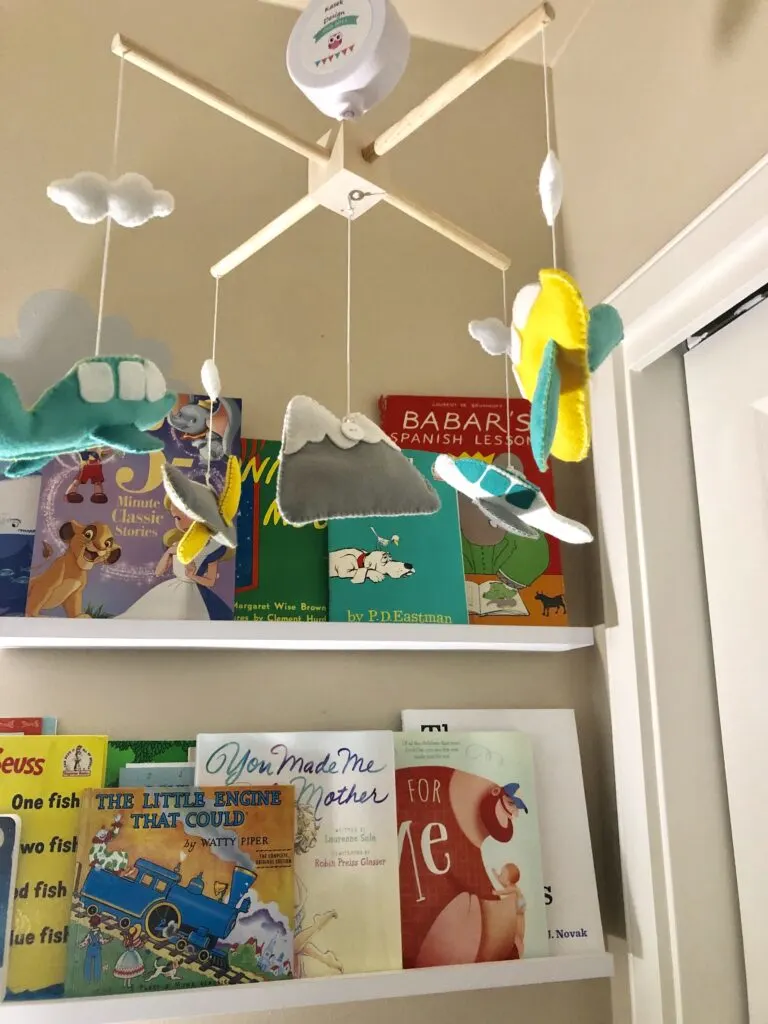
Certifications To Look For on Non-Toxic Paint
There are certain certifications to look for when it comes to paint. These include:
- Cradle to Cradle: The products are assessed across five sustainability performance categories: material health, product circularity, clean air and climate protection, water and soil stewardship, and social fairness.
- GREENGUARD: Paint formulas and manufacturing processes undergo rigorous testing to ensure compliance with VOC and hazardous chemical standards.
- Green Seal: Grants certification to paints, coatings, and adhesives based on their low-VOC content and safer formulas.
- Green Wise: Products undergo independent testing to ensure compliance with or surpassing VOC standards. Additionally, they strictly prohibit the inclusion of chemical components like methylene chloride, phthalates, and formaldehyde, as well as heavy metals such as cadmium, lead, and mercury.
4 Tips For Choose Non-toxic Paint For a Nursery
Here are a few tips that will help you make an informed decision every time you choose a non-toxic paint for your nursery:
- Check the ingredients label: Always read the label of the paint can. Ensure it’s labeled as low or zero VOC. This indicates a safer product in terms of indoor air quality.
- Certifications: Look for certifications such as GREENGUARD Gold, Green Seal, Cradle to Cradle, or Green Wise. These certifications indicate that the paint has undergone testing for low chemical emissions and is suitable for indoor environments.
- Allergies: Babies are very sensitive. Consider testing a small patch of paint on a less visible area to ensure there are no allergic reactions before painting the entire room.
- Choose colors and finishes that align with the mood you want to create in the nursery. Lighter shades can make a small room feel more open. Darker colors can add warmth and coziness to the space.
- Ask for samples: Many paint stores also offer sample pots that allow you to test colors and finishes before committing to a larger purchase.
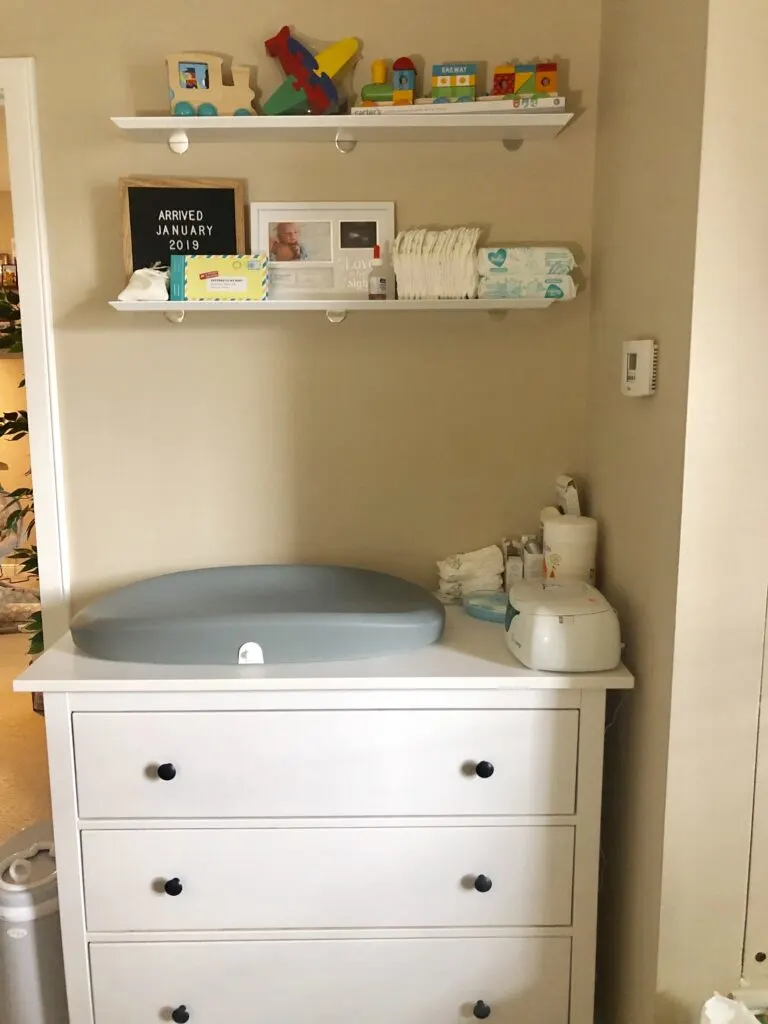
How To Prepare Your Nursery For Painting
Once you have chosen the best non-toxic paint for your nursery room, you need to prepare the room for painting. Here are some of the things you need to do:
- Remove the furniture and accessories: The first thing you need to do is to remove all the furniture and accessories from the room. This includes the crib, the changing table, and the rocking chair, as well as any toys, rugs, or curtains. Take out any item that can get in the way or get damaged by paint. Move them to another room or if they are too bulky to move, cover them with drop cloths. This will prevent any accidents or spills.
- Cover the floor and windows: Next, cover the floor and windows with plastic sheets. This will protect them from drips and splashes. Use painter’s tape to secure the edges of the plastic sheets to create a nice clean line.
- Prepare the walls: Use a damp cloth to wipe off any dust or cobwebs from the walls. If you have any loose or peeling paint on the walls, use a scraper to remove them. Fill any holes or cracks in. Then use a sandpaper to smooth out any rough areas. Finally, use a primer to prepare the walls for painting. A primer will help the paint adhere better and last longer on the walls.
- Ventilate the room: Even though non-toxic paints are safe and harmless, they can still have some odor or fumes that can be unpleasant. To avoid this, open all the windows and doors in the room and use a fan to circulate and refresh the air. Wear protective gear as well.
You are now ready to start painting your walls. Here is how to do it:
How to Apply Non-Toxic Paint For Your Nursery
Follow these steps to achieve a flawless finish:
- Gather supplies: Ensure you have all the necessary tools, including brushes, rollers, paint trays, and painter’s tape.
- Mix the paint: If the paint requires mixing, do so according to the manufacturer’s instructions. Make sure the paint is well-mixed and consistent in color.
- Start with primer: While non-toxic paints often have good coverage, using a primer can enhance the paint’s adhesion and color richness. Apply the primer evenly and allow it to dry before moving on to the paint.
- Apply multiple coats: Apply the first coat of paint evenly and let it dry as per the manufacturer’s recommendations. Depending on the paint’s opacity, you may need a second or even a third coat for a uniform finish.
- Mind the edges: Use painter’s tape to achieve clean lines along edges and corners. Remove the tape carefully while the paint is still slightly wet to prevent peeling.
- Drying and curing: Allow the paint to dry completely between coats and after the final coat. Follow the recommended drying times before moving furniture back into the room.
How To Maintain Non-Toxic Paint In Your Nursery
Your nursery’s freshly painted walls should continue to look beautiful for years with proper maintenance. Here are some tips to help you keep them in top condition:
- Regular cleaning: Dust the walls regularly with a soft, dry cloth to prevent dust buildup. Avoid using harsh chemicals or abrasive cleaners that can damage the paint.
- Tackle stains gently: If you encounter a stain, gently blot it with a damp cloth and mild soap. Test any cleaning solution in an inconspicuous area first to ensure it doesn’t affect the paint.
- Addressing scratches: Minor scratches can be repaired by touching up the paint. Keep a small amount of leftover paint on hand for such touch-ups.
- Refresh as needed: Over time, your nursery walls might lose their luster. When that happens, consider giving the room a fresh coat of paint to rejuvenate the space.
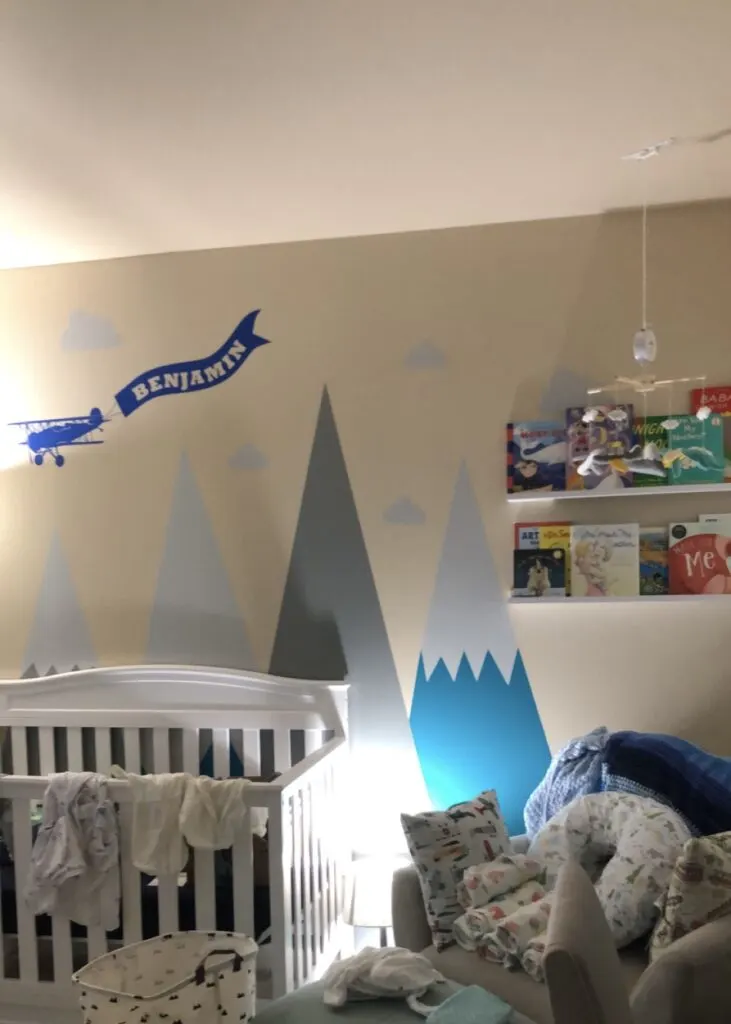
Common Mistakes to Avoid When Using Non-Toxic Paint For Your Nursery
Using non-toxic paint is great, but it can also be challenging and frustrating if you make some of these common mistakes. Here is what not to do when using non-toxic paint for your nursery:
- Buying low-quality or expired paint: Low-quality or expired paint can have poor performance. Issues like low coverage, uneven color, poor adhesion, or fast deterioration crop up. They can also have negative effects on your health and the environment. Always buy high-quality and fresh non-toxic paint from reputable brands and stores. And don’t forget to check the expiration date of your paint before using it.
- Skipping the primer: Priming is an essential step in preparing your walls for painting. It helps the paint adhere better and last longer on your walls. It also helps cover any imperfections on your walls, creating a smooth and even surface for painting. Skipping the primer can result in poor quality in your paint job. It also affects the durability of your paint and can lead to peeling, cracking, or fading. Always use a primer that is compatible with your type of non-toxic paint.
- Mixing different types of paint: A third common mistake that people make when using non-toxic paint is mixing different types of paint. This can lead to various problems, such as inconsistent color, chemical reactions, or separation. It can also compromise the quality and safety of your paint because it changes the ingredients and properties. Always use the same type of non-toxic paint for your project. Avoid adding any additives unless they are recommended by the manufacturer.
- Painting in humid or cold conditions: Humid or cold conditions can affect the drying and curing process of your paint. This can make it take longer or fail to harden properly. These conditions can also cause your paint to have defects like blistering or cracking. Always paint in dry and warm conditions, preferably between 50°F and 80°F and between 40% and 60% humidity. Avoid painting in direct sunlight as it can cause your paint to dry unevenly.
Frequently Asked Questions
How long does non-toxic paint last?
Non-toxic paints can last as long as conventional paints if properly maintained. With regular cleaning and care, you can enjoy a fresh look for years.
Is non-toxic paint safe for babies and pets?
Yes, non-toxic paints are safe for babies and pets. They emit no harmful fumes, making them a healthier choice for a nursery environment.
Where can I buy non-toxic paint?
Non-toxic paints are available at most paint stores, home improvement centers, and online retailers.
Is it safe to paint while pregnant?
Painting while pregnant can be safe as long as you take certain precautions and avoid exposure to potentially harmful chemicals. Here are some guidelines to consider:
- Choose the Right Paint: Opt for water-based paints, such as latex or acrylic, instead of oil-based paints. Water-based paints generally have fewer volatile organic compounds (VOCs) and are considered safer during pregnancy.
- Ventilation: Make sure the painting area is well-ventilated. Open windows and doors to allow fresh air to circulate and help minimize the inhalation of any fumes.
- Avoid Lead-Based Paints: Avoid working with paints that might contain lead. Exposure to lead can be particularly harmful during pregnancy, as it can affect the baby’s development.
- Limit Exposure to VOCs: While water-based paints are generally lower in VOCs, it’s still a good idea to limit exposure. If possible, have someone else do the painting, or take breaks and step outside periodically.
- Wear Protective Gear: If you decide to paint, wear protective clothing, gloves, and a mask designed to filter out paint fumes. This can help reduce your exposure to potentially harmful substances.
- Choose Low-VOC Paints: If you’re concerned about paint fumes, look for paints labeled as low-VOC or zero-VOC. These paints have reduced levels of volatile chemicals that can be harmful.
- Avoid Sanding and Stripping: Sanding and stripping old paint can release dust and fumes that may be harmful. If these tasks are necessary, consider having someone else do them or wearing a proper mask.
- Stay Hydrated: Drink plenty of water to help your body flush out any potential toxins.
- Consult Your Healthcare Provider: Before engaging in any painting activity or exposure to chemicals, it’s best to consult with your healthcare provider. They can provide personalized advice based on your health and the specific paint products you plan to use.
Remember that every pregnancy is unique, and individual sensitivities can vary. It’s important to prioritize your health and the health of your baby. If you’re unsure about the safety of painting during your pregnancy, it’s best to err on the side of caution and consider alternative methods or delay the project until after your baby is born.
Final Thoughts on Non-Toxic Paint For Your Nursery
Creating a nursery that’s both aesthetically pleasing and safe for your baby is important for every parent. As you can see, a key requirement in helping you achieve this goal is non-toxic paint.
When you use non-toxic paint in your baby’s nursery, you’re not only making a smart choice for your little one’s health but also contributing to a healthier planet. From water-based to mineral-based, each type of non-toxic paint brings its own set of advantages to the table. The final choice of what to go for depends entirely on you.
Hopefully, though, with the tips and tricks outlined above, you should be able to create the perfect nursery for your kiddo that is a haven of comfort, creativity, and care. Now that you know how to choose the right paint, how to prepare your walls, and how to apply and maintain your non-toxic paints, achieving this should be a walk in the park.
Remember, with every brushstroke, you are building a healthier future for your little one. So, don’t hesitate to go for one of the top non-toxic paint brands recommended in this guide. Good luck!
Like this post or found it helpful? We’d love if you share it!


GenThirty’s Non-Toxic Guides:
- Non-Toxic Baby Pool Options For Kids
- 11 Best Natural Baby Laundry Detergent Picks
- 15 Best Organic Baby Blanket Picks
- Best Organic Nursing Pillow (5 Top Picks)
- 6 Best Organic Cotton Crib Sheets
- 10 Best Organic Baby Pajamas – Mom Approved
- 6 Best Organic Toddler Pillow Options
- Non Toxic Sand For Sandbox: 3 Picks
- 8 Non-Toxic Couches For a Healthy Living Room
- 7 Best Organic Pillow Picks
- 4 Best Baby-Safe, Non-Toxic Paints For Your Nursery
- Top 7 Best Organic Baby Cereal Picks

